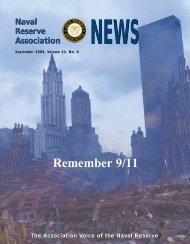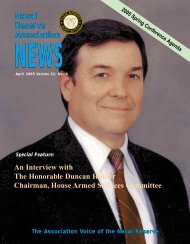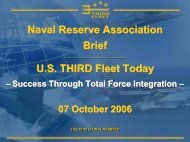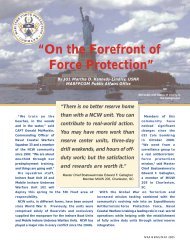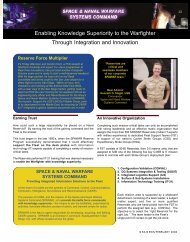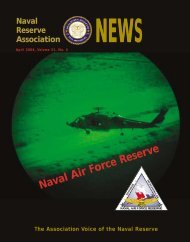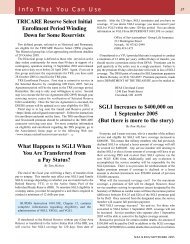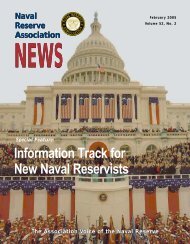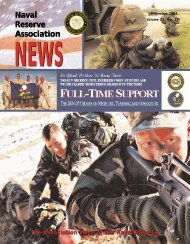Naval Reserve Association
Naval Reserve Association
Naval Reserve Association
- No tags were found...
Create successful ePaper yourself
Turn your PDF publications into a flip-book with our unique Google optimized e-Paper software.
S E A S C A P Eshore duty, it comes close to one year out of six, one out of fiveat least. People leave Active Duty because they don’t want thatlifestyle, right?) The GenXs and GenYs that I know intend tochange jobs frequently but always on an upward mobility trend,and none of the ones that I know consider one year away fromfamily as part of that plan. As a GenX Reservist, are my militaryyears contributing to my upward spiral or is it time out? Myopinion is that the question of sustainability rests with the familyand the employer, not the Reservist. Ultimately, even the mostpatriotic among us must balance the needs of family and sustaininga civilian career with the military requirement.So, how does this play out? I believe that the most likelyscenarios are these: There will be a number of enlisted andofficers for whom recall results in a pay increase, when hostilefire pay and federal tax exclusion is figured in. These individualswill likely take a second recall, and some will seek to remain onActive Duty. (No crystal ball here. This is already happening.)They will not represent the majority of those recalled and not themore senior nor the more highly skilled. For the majority, whenthey return to their civilian career, they will find that there wereprofessional opportunities missed during a year of absence. Somewill see the need to change careers. As that fact becomes obviousover time, they will not regret their service; but they will seek toreduce their likelihood of a second recall. More will move to theIRR. When they hear of involuntary recalls from the IRR (this isnot happening yet), they will leave entirely. Many enlisted willnot reenlist if they think that the second recall is coming (this isbeginning to happen). We, the Navy, are working hard to enticeenlisted leaving the Active Component to join the <strong>Reserve</strong>. Manywill, shielded from recall for a year. If they are successful inestablishing a civilian career during that year, they will leave the<strong>Reserve</strong> rather than risk upsetting that new career.The <strong>Association</strong> maintains rather close contact with theEmployer Support of the Guard and <strong>Reserve</strong> (ESGR), an arm ofthe Department of Defense whose mission is to educateemployers and encourage support of our military. ESGR isseeing a definite increase in complaints against employers fromreturning veterans. We, your <strong>Association</strong>, have gotten calls frompeople who think that they didn’t get a job because they are in the<strong>Reserve</strong> (illegal but essentially not enforceable). It is quite difficultto quantify these things with certainty, but it seems clear thatsome trends are developing. It also seems logical that, as publicopinion turns away from this war, employers will follow suit.On Thursday, 11 January, the Defense Department announcedsome new recall policies. On the plus side, recalls would be heldto a total of twelve months, including training prior to deployment.Recalls would also be done by unit not individuals, where possible.And, the official policy is one year recalled out of every six years.These are significant changes which Secretary Gates has beenquick to act upon, and he should be supported in these efforts.One of the changes which caused a real stir, however, was that theDepartment would no longer follow the policy of no more thantwenty-four cumulative months recalled but would now fall backon existing law which says twenty-four consecutive months. Thismeans that personnel, who have already been recalled for say,eighteen months, could be called again for as much as two years(one year, by policy). Our contacts in the jobs placement worldsay that this has had a big impact on small businessmen already.The long and short of this is: the sky is not falling, but the climatefor Navy Reservists and their employers is getting more difficult.Why would we think otherwise?Does this mean that our operational <strong>Reserve</strong> doesn’t work?Does it mean that we shouldn’t have a <strong>Reserve</strong> if they won’t comewhenever we want? Absolutely not! The <strong>Reserve</strong> is a surgecapability, and I believe that it means that the <strong>Reserve</strong> filled theshortfall caused by getting into this war without enough of theright forces. And don’t forget, our Navy Reservists are contributingmightily when not mobilized. The vast majority of our units havebeen contributing in a real way since Desert Storm when Title 10was reinterpreted to allow Reservists to do work rather than justtrain. However, things are out of balance when we think that weneed to recall the same Reservists multiple times in order to fieldthe forces that we need. Recently, a colleague of mine was in ameeting where one of the Service Chiefs (not the CNO) said thathe would like to call Reservists one or two years out of five orsix. He said that as if the difference between one year out of sixand two years out of five was a matter of nuance. The differenceis huge! And, it indicates a true lack of understanding about thepressure that puts on our “civilian military” and their employers.It is time to rebalance the forces, including a strategic <strong>Reserve</strong>.It is time to buy the forces that we need for the long war. The reasonthat we can’t do that takes us back to the third paragraph of thislong article – The President has not convinced us that we are in along war. The President’s budget now before Congress elevatesdefense spending to a bit over 4 percent GDP, where it has beenat about 3.6 percent. At the height of the Cold War, it was over 6percent. It is time to reacknowledge that forces in reserve are anecessary hedge that protects the country from that which can’tbe accurately foreseen. It is time to recognize that patriotism, inand of itself, does not create an unlimited source of manpower andemployer support. That is the seascape as we see it in Washington.Let us know how it looks from out there where the hull meets the water.––––––––––––––––––1 “Navy Reservists Work Alongside U.S., Coalition, Partner Nations”by RDML Tim Moon, <strong>Naval</strong> <strong>Reserve</strong> <strong>Association</strong> News,March 2007, Vol. 54, No. 32 “Stop-Work Ordered for Third LDS,” Defense News,15 January 20073 Statements by CNO, Admiral Michael Mullen,Retired Flag Conference, 15 November 20064 Comments by VADM John C. Harvey, Jr.,Retired Flag Officers Conference, 15 November 20065 Defense News, 29 January 20076 Briefing provided by RADM Bruce Clingan, N88,Retired Aviation Flag Conference, 12 January 20077 See “Reservists in Action,” <strong>Naval</strong> <strong>Reserve</strong> <strong>Association</strong> News,March 2007, Vol. 54, No. 3, page 318 United States Navy <strong>Reserve</strong> Strategic Plan, Office of the Chiefof Navy <strong>Reserve</strong>, 20 October 20069 Navy Times, 19 February 200710 CNATRA brief, Retired Aviator Flag Conference,12 January 200711 U.S. Department of Defense news release, 10 October 200620 NRA NEWS/APRIL 2007



